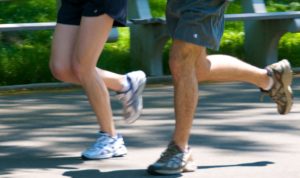 We all want to be fit, right? When we think of fitness, we generally think of how exercise can make our bodies healthy and strong. Importantly, mood and physical health are intertwined. The benefits of exercise go well beyond physical fitness. The mind-body connection is very real, and exercise can greatly improve mood. Overall, exercise is more effective than any antidepressant, and it’s free and has no side effects! Well, that’s assuming we don’t overdo the exercise and get injured. ;-). But our lives seem to become increasingly busy. And, if you have kids, squeezing in time to exercise can be particularly challenging. We all would probably like a fitness shortcut. Is there one? Well, possibly…
We all want to be fit, right? When we think of fitness, we generally think of how exercise can make our bodies healthy and strong. Importantly, mood and physical health are intertwined. The benefits of exercise go well beyond physical fitness. The mind-body connection is very real, and exercise can greatly improve mood. Overall, exercise is more effective than any antidepressant, and it’s free and has no side effects! Well, that’s assuming we don’t overdo the exercise and get injured. ;-). But our lives seem to become increasingly busy. And, if you have kids, squeezing in time to exercise can be particularly challenging. We all would probably like a fitness shortcut. Is there one? Well, possibly…
The Many Benefits of Exercise
We want to find the time to exercise because the benefits of regular exercise are impressive in number and scope. If someone were able to bottle up the benefits and sell them, they’d be beyond rich. These benefits have been well-documented in numerous studies and they include:
- Improved mood
- Decreased stress
- Improved sleep
Is There a Fitness Shortcut?
We can get these many benefits of exercising by working out for about 30-45 minutes 4-5 times per week. Now, we all seem strapped for time these days. If we count travel time to the gym and a shower after exercising, then maybe we have to carve out 2 hours for the workout. That’s quite a challenge! For so many of us, it causes us to just throw in the towel. But is there a fitness shortcut that will enable us to reap those many benefits without so much hassle? Is there a “fitness hack?”
I have some good news to report! There is some solid research to show that high intensity interval training (HIIT) can provide numerous health benefits with as little as a few minutes per day. This might sound too good to be true, but it isn’t!
What Short Workout Can Look Like
High intensity interval training, as the name implies, consists of short bursts of extreme effort followed by longer intervals of easy, recovery periods. For example, on a stationary bike, one might do a couple of minutes of a warm up, then pedal as fast as possible for 20 seconds, pedal slowly for 2 minutes, then pedal as fast as possible for another 20 seconds, then pedal slowly for 2 minutes, and so on. Research has found that workouts consisting of only 3 intervals of the 20 seconds of high intensity (one minute total of high intensity) is enough to produce substantial gains. This HIIT approach produces most of the same benefits that longer, but less intense workouts can produce (e.g., pedaling on the stationary bike at a moderate pace for 30-40 minutes).
The idea is that by pushing ourselves well out of our comfort zone, the body is forced to adapt to the strain. Perhaps the HIIT approach is more like the physical activity of our ancestors. We can imagine that our hunter-gatherer ancestors would be active but at a slower pace throughout much of the day. But then, when called on to hunt prey, fight, or flee, they would exert an intense burst of energy.
A Few Caveats
Before trying a HIIT exercise regimen, please consider these caveats:
- If you haven’t worked out at all in a while, don’t jump right into HIIT
- Be sure to talk to your doctor first
- Consider starting slowly so that the “high intensity” portion isn’t TOO high
It’s important not to confuse “high intensity” with “high impact.” One doesn’t need to do box jumps or similar activities for HIIT. Such exercises can be tough on the joints! One could do HIIT with low or no impact exercises, such as swimming. With swimming, one might try swimming 3 lengths of a 25-meter pool slowly and then one length as fast as possible. Do just 3-5 intervals of that and you’re done!
The Takeaway?
There is a long list of benefits of exercising that go beyond physical health. The mind and body are connected. Our mood and well-being improve as a result of regular exercise. But we are often so busy that setting aside enough time to exercise is a challenge. The good news is that there is a fitness shortcut. We can reap the benefits of exercise through short, but intense workouts known as high intensity interval training (HIIT). In my next blog, I’m going to cover the importance of not being sedentary. When it comes to our health and fitness, we will reap even more benefits if we engage in more frequent activity throughout the day.
